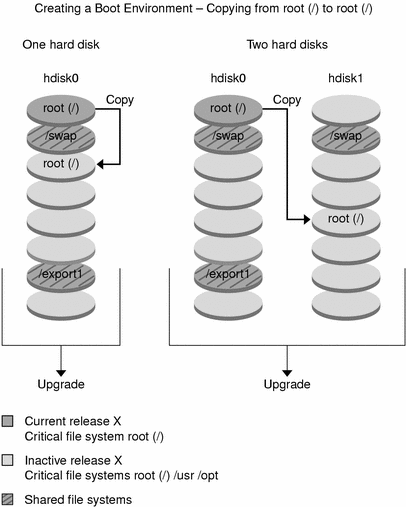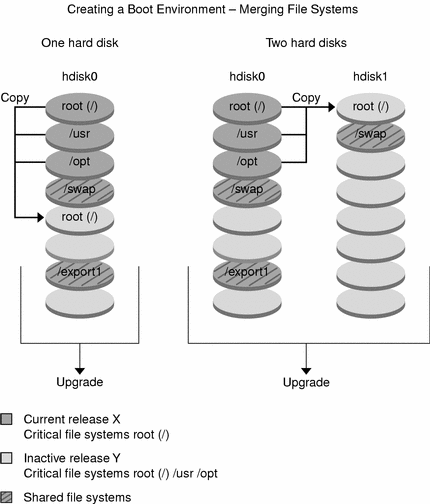Creating a Boot Environment Overview
Creating a boot environment provides a method of copying critical file systems from an active boot environment to a new boot environment. The disk is reorganized if necessary, file systems are customized, and the critical file systems are copied to the new boot environment.
File Systems Overview
Solaris Live Upgrade distinguishes between two file system types: critical file systems and shareable file systems. Critical file systems are required by the Solaris operating environment and are separate mount points in the vfstab of the active and inactive boot environments. Examples are root (/), /usr, /var, or /opt. These file systems are always copied from the source to the inactive boot environment. Critical file systems are sometimes referred to as non-shareable. Shareable file systems are user-defined files such as /export that contain the same mount point in the vfstab in both the active and inactive boot environments. Therefore, updating shared files in the active boot environment also updates data in the inactive boot environment. When you create a new boot environment, shareable file systems are shared by default. But you can specify a destination slice and then the file systems are copied. For more detailed information on shareable file systems, see Guidelines for Selecting Slices for Shareable File Systems.
Swap is a special circumstance of a shareable file system. Like a shareable file system, all swap slices are shared by default. But, if you specify a destination directory for swap, the swap slice is copied. You achieve this goal by using the character user interface or at the command line by using lucreate(1M) with the -m option. A limitation to splitting and merging swap slices is that the swap slice cannot be in use by any boot environment except the current boot environment or if the -s option is used, the source boot environment. The boot environment creation fails if the swap slice is being used by any other boot environment, whether the slice contains a swap, UFS, or any other file system. A swap slice is not required. For procedures on reconfiguring swap, see “To Create a Boot Environment (Character Interface)” Step 9, or To Create a Boot Environment and Reconfigure Swap (Command-Line Interface).
Note –
When you create file systems for a boot environment, the rules are identical to the rules for creating file systems for the Solaris operating environment. Solaris Live Upgrade cannot prevent you from making invalid configurations on critical file systems. For example, you could enter an lucreate command that would create separate file systems for root (/) and /kernel—an invalid division of root (/).
Copying File Systems
Creating a new boot environment entails copying critical file systems to another slice. The disk might need to be prepared before you create the new boot environment. Check the disk to make sure it is formatted properly:
-
Identify slices large enough to hold the file systems to be copied.
-
Identify file systems that contain directories that you want to share between boot environments rather than copy. If you want a directory to be shared, you need to create a new boot environment with the directory put on its own slice. The directory is then a file system and can be shared with future boot environments. For more information on creating separate file systems for sharing, see Guidelines for Selecting Slices for Shareable File Systems.
The process of creating a new boot environment begins by identifying an unused slice where the critical file systems can be copied. If a slice is not available or a slice does not meet the minimum requirements, you need to format a new slice. For the procedure on formatting a slice from menus, see “To Create a Boot Environment (Character Interface)” Step 6.
After the slice is defined, you can reconfigure the file systems on the new boot environment before the file systems are copied into the directories. You reconfigure file systems by splitting and merging them, which provides a simple way of editing the vfstab to connect and disconnect file system directories. You can merge file systems into their parent directories by specifying the same mount point, or you can split file systems from their parent directories by specifying different mount points.
For procedures on splitting and merging file systems, see the following procedures:
-
“To Create a Boot Environment (Character Interface)” Step 7 or Step 8
-
To Create a Boot Environment and Split File Systems (Command-Line Interface)
-
To Create a Boot Environment and Merge File Systems (Command-Line Interface)
After file systems are configured on the inactive boot environment, you begin the automatic copy. Critical file systems are copied to the designated directories. Shareable file systems are not copied, but are shared. The exception is that you can designate some file systems to be copied. When the file systems are copied from the active to the inactive boot environment, the files are directed to the newly defined directories. The active boot environment is not changed in any way. For procedures on creating a new boot environment, see Creating a New Boot Environment.
The following figures illustrate various ways of creating new boot environments.
-
Figure 30–1 shows the critical file system root (/) that has been copied to another slice on a disk to create a new boot environment. The active boot environment contains root (/) on one slice. The new boot environment is an exact duplicate with root (/) on a new slice. The file systems /swap and /export/home are shared by the active and inactive boot environments.
Figure 30–1 Creating an Inactive Boot Environment — Copying root (/) to root (/)

-
Figure 30–2 shows critical file systems that have been split and been copied to slices on a disk to create a new boot environment. The active boot environment contains root (/) on one slice. On that slice, root (/) contains the /usr, /var, and /opt directories. In the new boot environment, root (/) is split and /usr and /opt are put on separate slices. The file systems /swap and /export/home are shared by both boot environments.
Figure 30–2 Creating an Inactive Boot Environment — Splitting File Systems

-
Figure 30–3 shows critical file systems that have been merged and been copied to slices on a disk to create a new boot environment. The active boot environment contains root (/), /usr, /var, and /opt each on their own slice. In the new boot environment, /usr and /opt are merged into root (/) on one slice. The file systems /swap and /export/home are shared by both boot environments.
Figure 30–3 Creating an Inactive Boot Environment — Merging File Systems

- © 2010, Oracle Corporation and/or its affiliates
